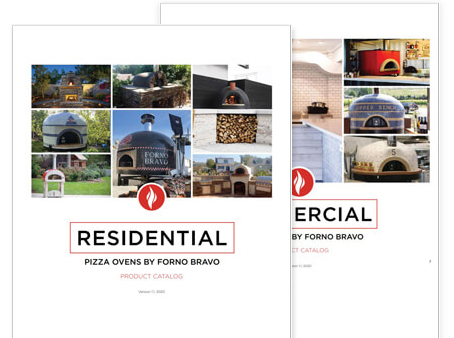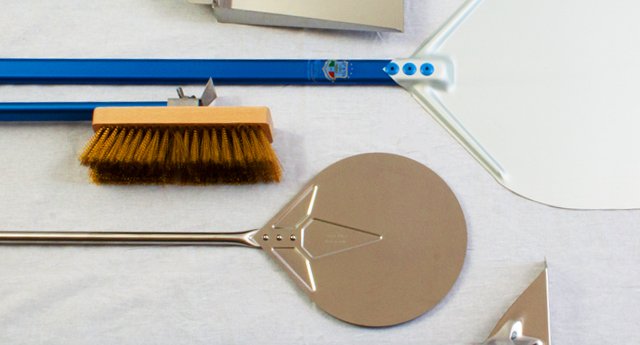
Pizza Peels 101
Aug 03, 2018Posted by Forno BravoWood fired cooking has been around for centuries, and the tools for getting food into and out of a hot, deep oven without burning yourself have developed right along with it. Pizza peels epitomize of this kind of tool. They are truly a case of form following function.
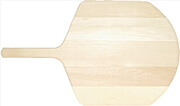
Our current word, peel, is derived from the French word Pelle, meaning “shovel.” The original simple wooden peels were easy to carve, inexpensive, and did not transfer heat to the baker’s hands. This traditional tool is still found in bakeries and pizzerias around the world.
However, innovations have continued in both shapes and materials to take advantage of new technology and to accommodate new food trends. Peels are now available in wood, steel, and aluminum, rectangular and round, solid and perforated, with long handles, as well as short, folding, and sliding handles, and mass market or artisan crafted peels. The extent of the options is mind-boggling!
Choices
With so many varieties to chose from, it can be hard to know what peel you’ll need for your pizza making operation. (Fair warning, you will usually need more than one!) In the following sections, we’ll break down peels into the basic categories of materials, shape, and size to help make your decision easier. To keep a slightly tighter focus, this article will just look at peels used for the round Napolitano-style pizzas traditionally cooked in Forno Bravo’s wood and gas fired ovens. (We’ll save talking about the peels used for the long, Roman-style pizza for another time.)
Let’s jump in!
1. Materials
Generally, peels are made of wood, steel, or aluminum. The choice of material affects weight, durability, ease of cleaning, and cost. Wood is the most traditional material, but is by far the heaviest and hardest to clean. Of the metal peels, aluminum is the most popular. It is the lightest, which is gentle on your arms and shoulders if you are moving a lot of pizzas or bread, but it is also the easiest to damage. An anodized aluminum peel has less friction with the dough (less sticking,) but they can also be the most expensive. Steel peels are more durable and can bear more weight, but are heavier to use than aluminum ones.
Some peels come with a perforated head. This feature saves weight, as well as knocking extra flour off the bottom of the dough, reducing burning and bitterness on the bottom of the pizza. The holes should not be too big, however, or the dough can sag down and get stuck.
- Pro Tip: Like good knives or cutting boards, pizza peels are an investment. Protect the milled edges by storing them in a Tool Rack or on wall hooks to keep them from getting dinged up. Do not leave wooden peels soaking in water, and periodically apply a coat of food-grade oil to extend their life and keep them from drying out.
2. Shape
The head of the peel comes in two primary shapes, rectangular or round.
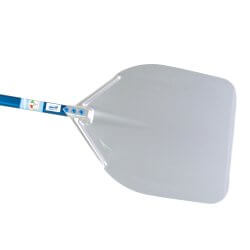
Rectangular Peel
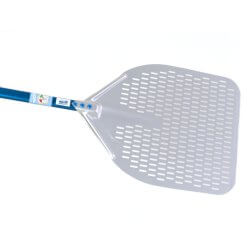
Perforated Peel
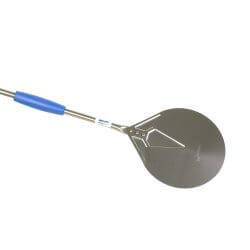
Round Peel
Large, rectangular peels are used for inserting pizza and bread into the oven. They have a milled (thin) front edge which makes it easier to slide the pizza off the peel and onto the oven surface. Many pizza makers will prepare their dough on a well-floured, cool counter or silplat, and then transfer it to the wooden or metal peel for final assembly of the sauce and toppings. Others will do the whole preparation on the counter, and then use a thin, metal peel to transfer it to the oven. Either way, you will want to lightly flour your peel first to reduce sticking. Many people choose to use a bit of cornmeal as well, to act like ball bearings to help the pizza slide easier. Whichever way you choose, prep your ingredients ahead of time and work quickly! The longer the dough sits on the peel, the stickier it gets, resulting in some baking catastrophes upon entry into the oven! >>See Anatomy of a Perfect Pizza Peel
- Pro Tip: Hold your peel handle up parallel to the floor and place the head on the oven deck. Give the handle a brisk push forward first to get the pizza moving, and then pull back on the peel with a quick jerk to slide the pizza off onto the deck. (The motion is like pulling a tablecloth out from under a plate.) Make sure the front edge of the dough is at the front of the peel and loose. Once the front edge hits the oven floor, it helps bring the rest with it. This motion can take a bit of practice to get the hang of comfortably.
Round peels are used for turning your pizza and removing them from the oven. They are typically metal and milled all around the side of the head to help you get underneath the pizza from many directions to quickly turn it. Round peels are almost always made of steel or aluminum; a wooden one would be too thick to slip under the edge of the pizza easily.
- Pro Tip: If you bake on a firebrick floor, the stone absorbs moisture from the dough, cooling it slightly. So when you turn a pizza, put it back in the same place on the oven floor that you took it from to prevent your crust from burning. Make use of the peel’s beveled edge and a slight rocking motion to smoothly rotate your pizza in place. It may take a couple of turns to fully shift the side of the pizza that was closest to the fire to the away position.
- You will typically be moving the turning peel in an arc (making a left to right smile shape.) Keep the inside edge of the peel touching the floor at all times. (The rocking motion happens as you move the peel from one edge to the other as you move through the arc.) Don’t forget you can bake a simple pizza crust and then practice turning it on a table or counter instead of inside the hot oven until you get comfortable.
3. Size
Peel Head: Uncooked pizza dough is very soft, so you will want the peel head to be larger than the pizza you are making. (i.e., If you are typically making a 10″ pizzas, get a rectangular peel with a 12″ head to give yourself some working room.) At the other end of the process, your round peel can be smaller than the final product, because a cooked pizza is stiff. For example, you can purchase an 8″ peel to move and remove 10″+ pizzas from your oven. The smaller size also makes the peel more maneuverable, especially if you are cooking more than one pizza at a time.
Handles vary dramatically in length. Choose the handle length that fits the depth of the oven you are using. For home ovens or professional electric ovens, generally 12″ – 24″ is more than sufficient. For artisan wood and gas fired ovens, 48″ to 78″ handles are common. Many higher-end aluminum peels come with a hollow handle to keep them light and increase productivity by reducing fatigue. Folding handles make for easier storage in your kitchen; long handles give your peel more rigidity and stability. Having a slide on the handle helps increase control as you work inside your oven and is a favorite feature of many professionals.
Think of your peel like an extension of your arms. The handle should fit your hand for a good grip, and oval handles are a better, more natural, shape than flat ones. The handle should be long enough to keep your arms away from the fire, but short enough to not interfere with your control.
- Pro Tip: Having more than one peel on hand is perfect for pizza parties where your guests top their own pies. Your guests can join in the fun, and you can focus on fire management and the cooking process instead of stopping after each pizza to prepare the next one. However, always check that the dough hasn’t stuck to the peel by giving it a little shake before transferring it to the oven. Better to add a bit more flour or a puff of air to loosen it up when you are still over the counter, than have to scrape a munched-up pizza off the hot deck of an oven!
Additional Resources
- Learn More about Using Pizza Peels
- Shop for Quality Pizza Peels in our Online Store
- Check out our Facebook Videos of Chef Leo Spizzirri’s live cooking demonstrations from the 2017/2018 Forno Bravo trade show booths. He uses multiple pizza peels in his creation of a variety of pizzas and other dishes.
- To learn more about making pizzas in general, including handling peels, you can Watch this Video from the Wood Fired Oven Chef. To learn more details about the arc/rocking method of turning pizzas, Watch Here.
- Purchase residential and professional peels, peel sets, and peel holders from our Web Store Here.
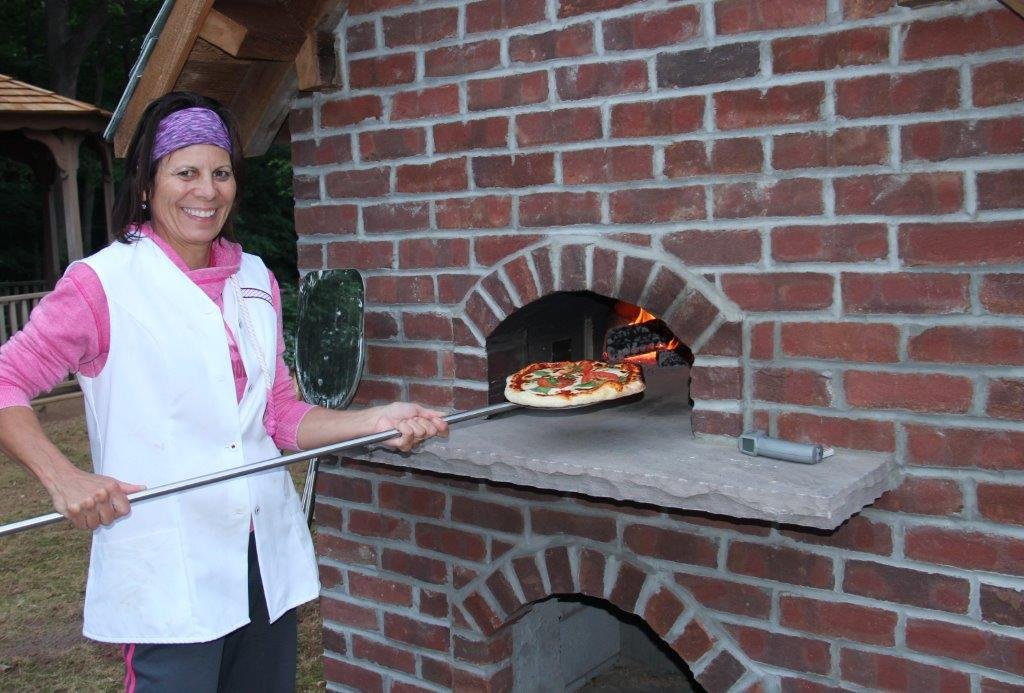
Alexandra W. working with her pizza peel in her Casa90 Pizza Oven



